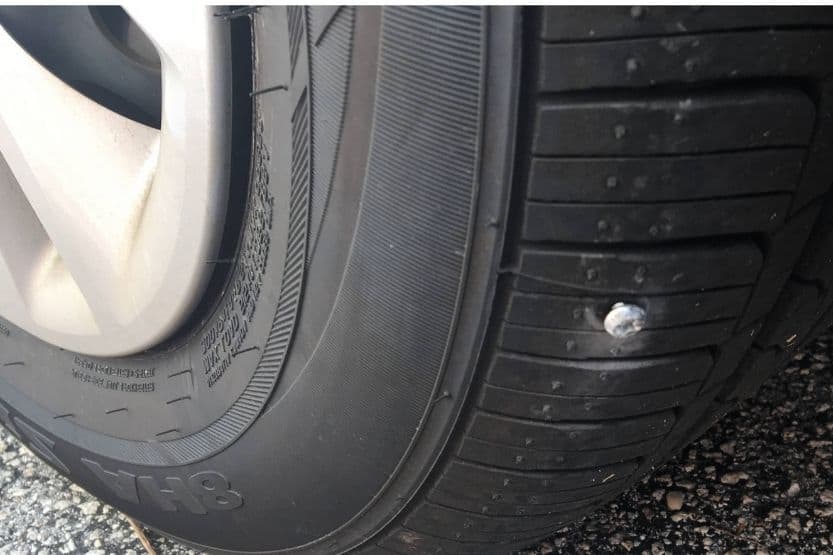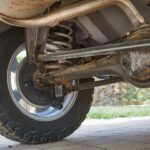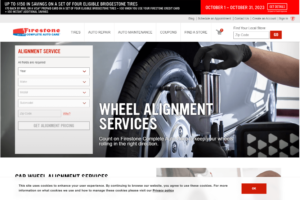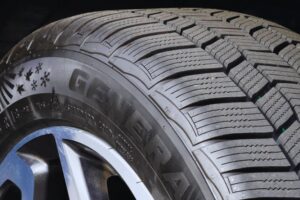The tires on your car perform millions of revolutions in its entire life. As such, they run the risk of being punctured by screws, nails, and other sharp objects. If there is a screw in your tire (with or without a leak), what should you do?
If the screw punctured the tire’s sidewall or close to it, the tire will need to be replaced soon. Likely, it will just take a few days until you will need to add air to the tire. If the screw is at the center of the tread area, you will need a proper tire repair as soon as possible.
It is potentially dangerous to continue driving with a screw in your tire. A blowout is likely to happen. A blowout is the sudden loss of air pressure in the tire, sometimes accompanied by the sound of an explosion. Furthermore, driving too long with a screw in the tire can ruin it. It will do more damage to the tire, and you may have to replace it instead of just having it patched up.
Read on to learn more about what you need to do if you find a screw in your tire, how to get it out and repair it, how long you will be able to drive with the screw still in, and other important info that will help you resolve this problem.
Screw in Tire – What to Do?

The majority of tire punctures are straightforward to repair. However, a screw in the tire is a different matter, especially if it is near or at the tire’s sidewall. If this is the case with your tire, driving your car continuously will ruin it completely – if it is not already. You may need to replace the tire instead of just plugging the hole.
When the screw has punctured the tire, a hole is already created. A screw in a tire (no leak) is developed where the screw is actually plugging that hole. But every time the tire rotates, that screw will rub against the wall of the hole. The hole will get bigger as this goes on and on.
Two things can happen after that: a) the tire could blow out or b) the hole grows bigger and bigger until it becomes unrepairable.
This is somewhat serious considering the risks you face on the road and a new tire’s cost. Therefore, you need to ensure that your tires are free of screws, nails, and other sharp objects that deeply embed themselves into the rubber.
If the screw has penetrated deep enough into the rubber, air can leak out. This condition is still repairable. But you still need a tire professional assessment whether he can still repair it or if it is wiser for you to buy a new tire.
If you hear a hissing sound coming from a tire, pull on the shoulder and stop your car. Inspect your tires to see if there’s any puncture in them. If there’s a screw in the tire, take out your spare tire from the trunk and replace the tire with a screw in it.
This is one of the reasons why your car or truck should always carry a spare tire. If the screw is not yet deeply embedded in the tire, you can try to remove it. Get a suitable set of pliers and grab the head of the screw and pull the thing out.
What to Do If the Screw Is Deeply Embedded into the Rubber
If the screw is deeply embedded into the rubber, take the tire to a tire repair shop nearest you. Have them look at the tire’s condition and ask them to remove and repair the tire if they can still repair it.
If the puncture is not so serious, the patching and vulcanizing that the tire center will do will be sufficient to make your tire usable. But if the puncture is on the tire’s sidewall, the mechanic might advise you to replace it altogether. Try to save the tire if there is still enough tread in it.
If you are beginning to drive, this situation may be stressful. Examine the tire and check if it is flat or not. If it is not flat, and there is no leak, don’t remove the screw yet. It acts as a plug for the hole that it has created.
But don’t drive the car. Replace the tire with the spare on the trunk. Then drive to the nearest tire repair shop and have them take a look at the punctured tire.
If you don’t have a spare tire and the tire is not flat, don’t touch the screw or the tire itself. Touching the screw may compromise the ‘seal’ that it created when it punctured the rubber. You can still drive the car but slowly until you reach the nearest tire shop.
Be aware that the longer you drive, the worst it can get. Therefore, you need to assess your situation correctly. Is it better to drive your car to the nearest tire shop or call for them and wait for the rescue team in your current location?
How to Get the Screw Out of the Tire and Repair the Tire
It is really very easy to remove a screw that has embedded itself into the tire. All you need is a pair of pliers, either a small long nose or ordinary pliers. If the head of the screw is still sticking out of the rubber, grab it with the pliers and then slowly pull the whole thing out.
However, if the head of the screw is already deep into the tire’s tread, you will need a small but sharp and pointed scraping tool. You will use this to carve out some small space around the screw head until you create enough space for the long nose pliers to grab the screw head. Once the pliers can grab the head, pull the screw slowly out of the rubber.
The correct way of repairing a punctured tire is by removing it from the wheel of the car. That way, you can inspect the tire in and out and determine where and how much damage the screw has done.
Be aware that any damage to the tire wall is unrepairable. Only punctures on the tread can be repaired.

Steps in Repairing Tire Punctures
Below are the general steps to repair a tire that has been punctured by a screw, nail, or other sharp objects:
- Locate the point where the screw has punctured the tire.
- Remove the tire from the wheels and then remove the tire from the rim.
- If you have located the screw, get your pliers, grab the screw’s head, and slowly pull it off.
- Squirt a small amount of buffing solution over the hole or the puncture.
- Use a buffing machine with sandpaper on it to buff the buffing solution. Do it in circular motions.
- Get a tire radial patch. Remove the sticky pads from their covering. Go to the inside of the tire where the hole is located and stick the radial patch to cover one-half of the hole. Ensure that half of the hole is covered by the patch.
- Use a tire chemical seal to seal the hole. Spread the liquid seal by using the brush that goes with the product. Spread it around the radial patch.
- Pull the rest of the radial patch all the way so that it completely sits on the inside of the tire and covering the entire hole, and the aluminum piece (of the patch) is removed from the rubber.
- Use cutting pliers or a small scissor to cut the leftover end of the patch.
- Use a tire retread and repair tool to roll over the whole patch. Roll it in any direction as you like but be sure to touch all the patch sections.
- Once all these are done, you can put the tire again on its rim and inflate it. If the tire holds air solidly, then you are successful in repairing the screw puncture.
General Guidelines on Tire Puncture Repairs
Below are the general guidelines for repairing screw-punctured tires:
- Tire technicians trained to repair punctured tires are the best service crew to repair punctured and damaged tires.
- Once the tire is repaired, it should be installed by the technician or mechanic involved in the repair.
- To thoroughly examine the tire, you should remove it from the rim to inspect the insides. There are times when you cannot see punctures or damage on the tire wall outside of the tire.
- If the tread puncture is 1/4 inch (6 mm) or more, the tire is no longer repairable.
- You can only do puncture repairs in the tread center area. If there are punctures at the shoulder or near the tire’s sidewalls, it has to be replaced altogether.
- Tires that have only 2/32 inch remaining tread depth in any tread area are no longer repairable. They are already too worn out to be repaired.
- If the punctures and damages are close enough to each other and the required repairs will overlap, you cannot repair the tire anymore.
- A patch or a plug should not be considered a permanent fix for a punctured tire. The patch or plug does not seal the tire’s inner liner and does not fill the void left by the screw in the tire. This void will allow moisture to enter the tire body, which will eventually corrode its steel belts.
- You should only repair tires according to the repair instructions and recommendations of their manufacturers.
What Is the Fast Way to Deflate a Tire?
How Long Can You Drive with a Screw in the Tire?
Your most immediate worry, if a screw punctures your tire, is the loss of air pressure. However, if the screw is not immediately removed from the tire, the puncture area will be unstable. It will eventually lead to the separation of the tire tread.
If you insist on driving your car with a tire punctured by a screw, it may result in more costly damage. The possibility of a blowout is very high if the puncture is located on the tire’s sidewall. This could even lead to more disastrous consequences.

Some car owners have driven their cars for 3 weeks with their tires punctured by a nail in the tread center section. There can be a screw in the tire and no leak if the screw plugs the hole perfectly. If the puncture is at the sidewall or close to it, a tire could not have lasted that long.
It really depends on the location of the puncture. If the screw is tiny, perhaps you will be able to go around driving for weeks without noticing any change in your tire pressure. However, if the screw is big, your tires could go flat anytime.
The best thing to do is to have the puncture fixed right away – if you can fix it. But if you can’t repair it, there is no other alternative but to buy a new one. It’s better than meeting an accident while you are driving with a questionable tire on your wheel.
How Much Will It Cost?
Repairing the puncture is not that costly. Generally, the cost will be anywhere between $10 and $20. Some tire sellers would do it for free if you bought your tires from them.
It is also possible to do it on your own if you have the know-how and have the proper equipment and tools to do the job. But since it costs a minimal amount, have it done at the nearest tire repair shop.
Conclusion: Tire Screw Repair
If the screw is on the tire’s sidewall or near to it, you will need to replace the tire soon. But if the puncture is on the top of the tread, you may still repair the tire by removing the screw and patching or vulcanizing the hole.
It may take a few days before you need to add air to your tire. To avoid this situation, check your tires regularly. Make sure that no sharp items are embedded in the tires. It is easier to remove a screw that has not deeply punctured the rubber rather than a screw that has been there for weeks and months.
Related reading:
Nail in Tire [How to Repair? What to Do?]


![Radiator Leak [Causes and How to Fix] Radiator Leak](https://roadsumo.com/wp-content/uploads/2021/12/radiator-leak-150x150.jpg)


![Transmission Fluid Leak When Parked [12 Causes and How to Fix] transmission fluid leak when parked](https://roadsumo.com/wp-content/uploads/2021/06/transmission-fluid-leak-when-parked-150x150.jpg)
![Discount Tire Tire Rotation Cost [How Much Is It?] how much does a tire rotation cost at discount tire](https://roadsumo.com/wp-content/uploads/2022/04/how-much-does-a-tire-rotation-cost-at-Discount-Tire-150x150.jpg)


